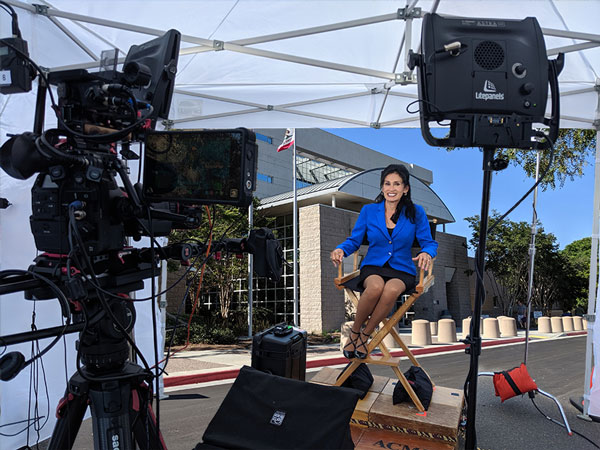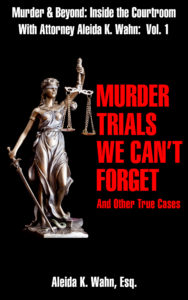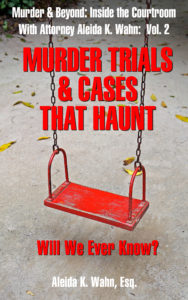

The funeral of Officer Jonathan De Guzman. Photos from the San Diego Police Department and John Gibbins
Jesse Gomez Rendered A Night of Terror
It was a case that captured national attention, shattered lives, and broke endless hearts. The night of July 28, 2016, San Diego Police Officer Jonathan De Guzman, known affectionately as “JD,” and only 43 years of age was killed in the line of duty. Gunned down mercilessly as he sat in his patrol car. A veteran of the force, he would never return to his wife and two young children. Who could have brought such utter devastation? And why?
His partner, Officer Wade Irwin, took a bullet to the throat, but managed to send out a desperate plea for help. As he sat propped against his patrol car, his hand on his throat stemming the constant flow of blood, and struggling to breathe, he whispered into his radio, “1199! 3700 Acacia Grove. Hispanic male running eastbound.” 1199 is the emergency code for “Officer Down,” and every unit hearing those dreaded words raced at breakneck speed to the scene. Officer Irwin was the fortunate one, as he survived his deadly encounter, though spending a month in the hospital.
Police officers swarmed the scene, and Jesse Gomez was apprehended that very night and soon charged with murder and attempted murder. A special circumstance allegation of murder of a police officer could bring the death penalty.
On August 17, 2021, five years after that horrible night, Jesse Gomez’ murder trial began in the courtroom of San Diego Superior Court Judge Frederick Link. The courtroom was filled to capacity, and people were turned away when the courtroom benches could hold no one further. They would have to watch the news screens in the hallway as the media was filming every minute. Jesse Gomez, now 60 years old, sat silently between his attorneys, perfectly attired in his dark suit, his hair cropped short, and his goatee white.
Would there finally be an answer to why?
The Prosecution’s Opening Statement
Deputy District Attorney Valerie Summers walked silently into the courtroom well and meticulously placed two huge poster boards bearing shinning photographs of Officer Jonathan De Guzman and Officer Wade Irwin. She then walked before the jury and began telling them about that fatal night.
On July 28, 2016, Officer Jonathan De Guzman and Officer Wade Irwin prepared for their shifts, ready to “fulfill their solemn duty to watch over and protect us.” They put on their police uniforms, bullet proof vests, and secured their guns firmly in their holsters. But “none of this equipment is gonna save them from what this defendant is gonna do,” pronounced Summers as she gestured toward Jesse Gomez. The officers were assigned to the Gang Suppression Team, a unit devoted to curbing gang violence and getting guns off the street. As part of a “Saturation Patrol,” their mere presence was designed to prevent and deter crime.
It was almost 11:00 p.m. and they had only one hour remaining of their eight hour shift. At midnight they could go home to their sleeping families. Then they received a final directive, to take one more pass through the Shelltown neighborhood. As they drove down Acacia Grove Way in a marked patrol car, two men caught their attention. The men were walking together, but suddenly split up, one moving to the sidewalk on the north side and one to the south side. Officer De Guzman said, “That’s weird. They just split up.” Officer Irwin thought the man on the south side was someone he had previously arrested. They watched the two men and decided to turn around to check it out. They did a U-turn and slowly returned.
Jesse Gomez: Not Tonight, Not Tonight
“Jesse Gomez had a problem” said attorney Summers. He had an open container, methamphetamine in his system, and a concealed weapon. As a previously convicted felon, he knew he was forbidden to possess a gun. If they found this gun he knew he was going back to prison.
Jesse Gomez had previously been arrested for possession of weapons. He was granted probation and forbidden to have any guns. In 1994, guns were found in his house, and he received a two-year prison term. In 2002, he was walking down the street with two open beers. When an officer asked him if the beer was open, Jesse made a move like he was going for a gun. Ultimately, the gun was thrown into a nearby yard, and Jesse Gomez was convicted as a felon in possession of a gun. He received another year in prison.
As Officer De Guzman and Officer Irwin drove down the street, Jesse Gomez made a decision. “Not tonight. Not tonight,” said the prosecutor. He was not going back to prison. As the officers made the U-turn and slowly rolled towards him, Jesse Gomez unholstered his gun. “Not Tonight!”
Officer Irwin stepped out of the passenger side of the patrol car and asked the man something like, “Hey, you live in the area?” Jesse Gomez shot one time. Officer Irwin was hit in the throat and ended up on the ground, seated against the police car. Jesse then turned his attention to Officer De Guzman who was seated in the front seat of the patrol car. He fired five times in quick succession emptying his gun. Officer Irwin heard shot after shot and feared for his life and his partner’s life.
“What Jesse Gomez didn’t count on this night was Wade Irwin refused to die,” said Summers. Officer Irwin, while stemming the flow of blood, was able to draw his weapon. He fired again and again, nine times in total. And he thought he hit him.
Jesse was hit twice and now had to escape. He ran easterly on 38th street, moving towards a route most likely to get away. He went to the end of the street and towards a ravine, where there were bushes, trees, and dense foliage. “The perfect escape route.” But for Officer Irwin he would have gotten away.
1199! Officer Down!
Officers Kelly Stewart and Aziz Brou were on a detention stop a few blocks away when they heard six shots followed by nine shots. Officer Kelly Stewart immediately put out a radio call, “Anyone hear those 116s?” the code for shots fired. He then heard a clicking sound over the radio like someone trying to say something. There was nothing at first, but finally the words come through, “1199. 3700 Acacia Grove. Hispanic male running eastbound.” He could hear the struggle in Officer Irwin’s voice. Prosecutor Summer then played the video from Officer Stewart’s body worn camera so the jury could hear the gunshots for themselves, and the desperate call for help.
Officer Stewart and Officer Brou immediately ended their detention and jumped in their patrol car, racing to the scene with their lights flashing and siren blazing. Officer Stewart ran to the patrol car and found Officer De Guzman slumped in the front seat, lifeless and unconscious. He pulled him out of the car onto the street, talking encouragement to him the entire time, “It’s OK JD. You’re gonna be OK JD.” He pulled off his armour and found he had been shot in the side, a place where the bullet proof vest provided no protection.
Sergeant Alan Butchart arrived shortly thereafter and surveying the destruction, put out a broadcast to all units, “1199. 3700 Acacia Grove. I have two officers down.” Officers from all sectors soon descended to aid their fallen comrades.
A police helicopter circled overhead and told the officers to just put Officer De Guzman into a car and get him to the hospital. But they couldn’t get Officer De Guzman back into his own patrol car, as Officer Irwin was being tended to near the rear tire. So, they carried Officer De Guzman to a larger police vehicle and Officer Stewart got behind the wheel, driving upwards of 120 mph.
Officer Jennifer Severson got into the backseat with Officer De Guzman, straddling his body so she could render constant aid. As his mouth repeatedly filled with blood, she cleaned it out. All the while she spoke encouragement to him, “Stay with me. You’re gonna be ok.” She felt him squeeze her elbow. The blood filling Officer De Guzman’s mouth was once filled with bubbles, but suddenly she noticed the blood no longer contained any bubbles.
Arriving at the hospital, the officers did not wait for a gurney. Instead, they carried Officer De Guzman by his arms and legs into the emergency room where the medical staff began to work on him.
Meanwhile, back at the scene, other officers helped Officer Irwin who was sitting up against the patrol car. One officer grabbed gauze with quick clot to try to stop the bleeding. Officer Irwin relayed, “I think it’s Fuzzy from Gamma.” They tried to put Officer Irwin into the patrol car, but it was too small, and Officer Irwin could not breathe. As they scrambled for a larger vehicle, the ambulance arrived.
Officer Brou rode to the hospital with Officer Irwin, who asked him to call his wife and daughter. Officer Brou responded, “You’ll be able to call them yourself.” Officer Irwin told him he saw two guys and the guy who shot him had white socks pulled up and was carrying a grocery bag.
And Then They See It…A Blood Trail Leading to Jesse Gomez
As both officers were finally at the hospital, all attention returned solely to the scene. It was an active scene with more officers arriving by the minute, and the whereabouts of the suspect still unknown. “And then they see it…a blood trail,” declared attorney Summers. There was a blood trail from the driveway of 3700 Acacia Grove winding down the street to the corner house at 1364 38th Street. The blood trail went into a ravine where there was bushes, bamboo, and dense trees.
It was too dangerous for an officer to go into the ravine, so they called in a police dog. Mickey. They shouted out commands, “Come out of the bushes or you will be bit and shot.” There was no response and Micky was sent in.
The officers saw Jesse Gomez lying face down on the ground and yelled commands, “Show us your hands!” There was no response. Mickey was still on the scene and officers descended into the ravine. Jesse Gomez was unconscious. They handcuffed him and gave him medical aid, performing a sternum rub trying to bring him to consciousness. He would not wake. They put him on a backboard, but the ravine was steep, and they could not get him out. They had to use ropes to lift him up, straining from the effort.
On his belt was an empty holster. Close by his body, they found a gun and a loaded magazine.
The Call: Officer Jonathan De Guzman Has Died
As Sergeant Butchart was working the scene, he received a call to inform him of the heartbreaking news: Officer De Guzman had died. Officer Brou was still at the hospital, standing outside the trauma room, never leaving his friend for a second. A captain instructed Sergeant Butchart to gather his team and to go to the hospital to say goodbye.
Jesse Gomez Identified
Jesse Gomez was taken from the ravine to the hospital, but he had not yet been identified. The police pulled a booking photograph of Fuzzy, but it did not match as Jesse Gomez had a lightning bolt on the right side of his neck. The police called for a mobile fingerprint scan and a match was made to Jesse Gomez.
At the hospital, when Officer Irwin was out of surgery, he gave a statement of everything that happened that night. He also said he did not have time to activate his body worn camera before he was shot. Right before he put out the call for help, he activated it.
Forensics Will Tell and One Bullet Is Still Inside Jesse Gomez
Prosecutor Summers told the jury “forensics will tell” the story. She then listed the evidence, beginning with the blood trail which wound from the driveway down to the defendant in the ravine. Inside the grocery bag was a beer and a bag of methamphetamine. In the ravine, they found a clear plastic bag with five cartridges. They also found the gun and a fully loaded magazine. Summing it up, she said the defendant had methamphetamine in his system, a half-drunk beer, a gun with six rounds, and 12 more. After Jesse Gomez emptied his gun, he reloaded. All of the bullets were from the gun found in the ravine. His blood was found on the reloaded gun and magazine.
By Officer De Guzman’s police car, there were five S&B BRV spent casings on the ground and one on the passenger seat. There were six projectiles, four on the ground, one inside the police car, and one found during Officer’s De Guzman’s autopsy.
The 9mm casings from Officer Irwin’s gun were all found around where he was seated. One bullet hit the garage and one bullet hit a wall, but it first hit Jesse Gomez as it had his DNA on it. The prosecutor then revealed a shocking fact: one bullet remained inside Jesse Gomez himself. She told the jury she could not show it to them, but she would show them the x-ray.
Conclusion
As attorney Summers wrapped up her opening statement, she said, “But for Wade Irwin, Jesse Gomez would have gotten away with it.” Jesse Gomez got to the ravine, reloaded, and passed out. When an officer is killed in the line of duty, it is known as the end of his watch attorney Summers continued. Then she closed with, “Jesse Gomez murdered Officer Jonathan De Guzman. July 28, 2016, marks the end of Officer De Guzman’s watch. Today marks the beginning of yours.”
The Defense’s Opening Statement
Jesse Gomez Was Afraid for His Life
San Diego Public Defender Jessica Petry walked confidently before the jury and then took them to the scene from Jesse Gomez’s point of view. “Imagine something…It’s late, it’s dark, and you are alone, and you are walking down the street of a neighborhood that you know is dangerous. Bright blinding headlights approach from behind. A man gets out, and approaches you from behind.” Confronts you. “That is what this case is about. Jesse Gomez was afraid for his life.”
A Gang Threat that Was a Lose-Lose for Jesse Gomez
Attorney Petry described Shelltown as a hub of crime and violence. A “gang-infested neighborhood.” Being confronted by “Where you from?” was an intimidation tactic used by gang members offering up a challenge. “There is no right answer to that question,” insisted attorney Petry, going on to say, “It almost always precedes violence – a beat down, a stabbing, a shooting.” It is a “frightening lose-lose proposition” for anyone confronted with that question.
Law Enforcement Never Identified Themselves
Attorney Petry said law enforcement did not signal they were approaching. The black and white police car did not have a light bar on top, so there were no lights in the dark night. Neither was there a siren. Instead, it was a “slow creep up in darkness.” “It will be clear on that night, Jesse Gomez did not know law enforcement was trying to contact him,” assured Petry.
She then moved to Jesse Gomez’ state of mind. He was walking down the sidewalk, on methamphetamine, which she said causes paranoia, a sense of fight or flight, and false perceptions. The light was obscured by the trees and Jesse would have only seen blinding headlights approaching. Then “Where are you from,” followed by six shots, then nine shots. And “within seconds, it’s over.”
Attorney Petry went on to say the jury would hear no evidence Jesse Gomez was looking to target police officers.
The Forensic Evidence Cannot be Relied Upon
There was frenzied activity that night. Law enforcement had two goals said Petry: to aid the officers and to maintain scene security. In the chaos, forensic evidence was trampled upon, moved, and altered. “There’s a cost to that chaos,” stated Petry. The evidence was compromised. “You can’t rely on it.”
You will see the darkness for yourself, but you won’t see body worn camera continued Petry. Despite clear policy when to turn it on, and ample time to do so before contact with the man they thought was Fuzzy, it was not turned on.
Jesse Gomez Thought He Was Going to Die
Jesse Gomez was on that curb line. What was going through his mind? He was on methamphetamine, walking alone in the dark in a gang infested area. “After hearing all the evidence, it will be clear Jesse Gomez did not know law enforcement was trying to contact him,” promised attorney Petry. There was no announcement, “San Diego Police” or any other type of identification. Jesse Gomez was met with a gang threat, and he fired as “he thought he was gonna die!”
Will Jesse Gomez Receive the Death Penalty?
If Jesse Gomez is convicted, he could face the death penalty. The trial would enter into a second phase, called the penalty phase where the jury will decide whether Jesse Gomez should receive the death penalty or life in prison without the possibility of parole. The trial is expected to last as long as two months.
About Aleida K. Wahn, Esq.


I am an attorney, award-winning true crime writer, and legal analyst of criminal cases. I cover criminal trials and write stories and books about compelling, gripping, and unforgettable cases that impact our world. I take you into the courtroom in high-profile murder trials, rape cases, crimes of passion, cases involving mental illness, deviant behavior, and more. I have a deep passion for true crime, criminal law, and all aspects of the criminal justice system. I have appeared as an expert on true crime shows, including “48 Hours,” “Snapped,” and “The Dead Files,” and provided legal analysis on high-profile criminal trials on Court TV, the Law & Crime Trial Network, Fox 5 News, ABC 10 News, and KUSI News. I also create and host shows with the Del Mar Television Producers Group, addressing criminal justice and social issues in recent criminal trials.
I provided my insight and legal analysis on Court TV and the Law & Crime Trial Network of the high-profile trial of former NFL star Kellen Winslow Jr. It was a trial that captured the nation as the heralded ex-football star with fame, fortune, and a famous name stood accused of multiple rapes and other sex crimes involving five women. As the trial delved into shocking facts, complicated legal issues, and unexpected twists and turns, I was there for every minute. After the trial, I wrote a book on the case, going behind the headlines to share the extraordinary details of what happened inside the courtroom. Judging Winslow Jr.: From NFL Star to Serial Rapist? Inside the Shocking Rape Trial of Kellen Boswell Winslow II is now available on Amazon.
I am passionate about telling true crime stories, as these penetrating stories have the power to move us all, while highlighting societal issues which need to be addressed. I have personally seen the human devastation which is present in each trial and believe there is a lesson to be learned in every single case. It is through awareness and examining critical issues society can effect change and even make new laws. To learn more, please visit: https://www.aleidalaw.com.
Read about the gripping and unforgettable trials that I have covered in my latest books:



